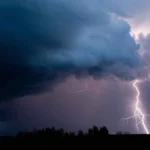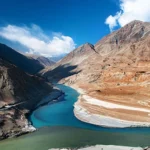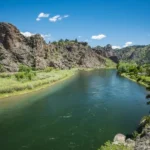
Nestled amid the breathtaking red rock landscapes of the American Southwest, Lake Powell stands as a remarkable testament to both natural beauty and human ingenuity. As the second largest human-made lake in the United States, it has become a beloved destination for outdoor enthusiasts, families, and adventurers alike. With its stunning vistas, rich history, and complex ecological significance, Lake Powell offers a wealth of fascinating information waiting to be explored. In this blog post, we will delve into 25 intriguing facts about this iconic reservoir, uncovering its origins, environmental challenges, and the unique features that make it a must-visit location. Whether you’re a seasoned visitor or just curious about this remarkable body of water, these facts will deepen your appreciation for Lake Powell and its place in the heart of the American landscape.
Beauty of Lake Powell: Lake Powell is renowned for its stunning landscapes, characterized by striking red-rock canyon walls that contrast beautifully with its clear blue waters. This picturesque setting has made it a favorite destination for photographers, nature enthusiasts, and tourists alike. The unique geological formations and vibrant colors create a breathtaking backdrop, attracting millions of visitors each year who come to experience the natural beauty of this man-made reservoir.
Water Source for Millions: The Colorado River, which feeds Lake Powell, serves as a critical water source for approximately 40 million people living in the American Southwest. This river is vital for domestic, agricultural, and industrial water supply in states such as Arizona, California, Colorado, Nevada, New Mexico, Utah, and Wyoming. The management of water resources from Lake Powell is crucial, especially during periods of drought, as it plays a significant role in sustaining communities and ecosystems in the region.
Creation of Lake Powell: Lake Powell was formed by the construction of the Glen Canyon Dam, a monumental engineering project that stands 710 feet tall. Completed in 1963, the dam was built to control the flow of the Colorado River, provide hydroelectric power, and create a reservoir for water storage. The creation of Lake Powell involved flooding the Glen Canyon, transforming the landscape and altering the natural flow of the river, which has had lasting impacts on the environment and local ecosystems.
Unique Shape: The shape of Lake Powell is often described as resembling a snake with a porcupine in its belly, a metaphor that captures its winding, serpentine structure. This unique configuration is the result of the numerous canyons and tributaries that feed into the lake, creating a complex network of waterways and inlets. The intricate shape not only contributes to the lake’s aesthetic appeal but also provides diverse habitats for various species of fish and wildlife.
Water Capacity: Lake Powell has an impressive capacity, able to hold up to 24 million acre-feet of water. This vast volume of water is critical for meeting the needs of the surrounding regions, especially during times of drought. To put this capacity into perspective, if all the water in Lake Powell were to be poured into the state of Massachusetts, it would create a water level that reaches waist high. This immense storage capability makes Lake Powell one of the largest reservoirs in the United States.
Historical Significance of Glen Canyon: Before its transformation into Lake Powell, Glen Canyon was celebrated as one of the most beautiful river rafting destinations in the United States. The canyon’s stunning rock formations, vibrant colors, and pristine waters attracted adventurers and outdoor enthusiasts. The flooding of Glen Canyon to create Lake Powell resulted in the loss of this natural wonder, leading to ongoing debates about the environmental and cultural impacts of damming the Colorado River.
Opposition to Reservoir Creation: Critics of Lake Powell often refer to it as “Lake Foul,” highlighting their objections to the destruction of natural landscapes for the creation of human-made reservoirs. This opposition stems from concerns about the ecological consequences of flooding canyons, the loss of biodiversity, and the alteration of the natural river ecosystem. The debate surrounding Lake Powell reflects broader discussions about the balance between human development and environmental preservation.
Impact of Drought and Climate Change: Since the year 2000, Lake Powell’s water supply has been significantly affected by drought, climate change, and overuse. These factors have led to a dramatic reduction in water levels, raising concerns about the sustainability of water resources in the region. The ongoing challenges posed by decreasing water availability highlight the importance of effective water management strategies and the need to address the impacts of climate change on vital resources.
Accessibility of Landmarks: Due to the reduction in water levels at Lake Powell, landmarks such as the red-rock La Gorce Arch, which was once easily accessible by boat, now require a half-mile hike to reach. This shift illustrates the tangible effects of declining water levels on recreational activities and access to natural attractions. As the landscape continues to change, visitors may need to adapt their plans to explore the lake and its surroundings.
Glen Canyon Institute’s Advocacy: In 1996, a group of concerned Utah residents founded the Glen Canyon Institute to advocate for the removal of Lake Powell’s dam and the restoration of Glen Canyon to its natural state. This organization aims to raise awareness about the ecological and cultural significance of Glen Canyon, promoting discussions about sustainable water management and the potential benefits of restoring the area to its original form.
Significant Water Level Drop: Over the past two decades, Lake Powell’s water level has dropped by an alarming 140 feet, reflecting the ongoing challenges of water scarcity in the region. This decline has raised concerns among stakeholders regarding the sustainability of water resources and the potential long-term impacts on the environment, recreational activities, and local economies. The significant drop in water levels has prompted discussions about the future management of the reservoir and the need for innovative solutions to water conservation.
Size Comparison: Lake Powell is recognized as the second largest human-made lake in the United States, following Lake Mead. Its vast expanse covers approximately 162,000 acres and stretches over 186 miles in length, featuring more than 90 side canyons. The sheer size of Lake Powell not only makes it a key resource for water storage and recreation but also a vital component of the Colorado River system, influencing water management policies across the Southwest.
Cultural Commentary: The writer Edward Abbey famously criticized the submersion of Glen Canyon to create Lake Powell, likening it to burying the Taj Mahal in mud until only the spires remain visible. Abbey’s poignant remark underscores the cultural and historical significance of Glen Canyon and serves as a reminder of the loss of natural beauty due to human intervention. His writings have inspired many to reflect on the importance of preserving natural landscapes and the complexities of environmental stewardship.
Historical Figure: Lake Powell is named after Major John Wesley Powell, who led the first expedition to explore Glen Canyon in 1869. Powell, a geologist and explorer, is celebrated for his contributions to the understanding of the American Southwest’s geography and natural history. His legacy continues to resonate today, as discussions about water management and environmental conservation are informed by the historical context of his explorations and the subsequent changes to the landscape.
Dam Specifications: The Glen Canyon Dam, which created Lake Powell, is the second highest concrete arch dam in the United States, standing just 16 feet shorter than the Hoover Dam. The dam’s construction was a significant engineering achievement of its time, designed to provide hydroelectric power and regulate water flow in the Colorado River. Its height and structural design are critical for managing the immense pressure of the water stored in Lake Powell, playing a vital role in regional water supply and energy production.
Canyon Network: In addition to the main body of water, Lake Powell features over 90 side canyons that extend into its depths, creating a complex and intricate landscape. These side canyons offer unique opportunities for exploration, boating, and hiking, allowing visitors to access remote areas that were previously difficult to reach. The diversity of these canyons contributes to the recreational appeal of Lake Powell, making it a popular destination for outdoor activities such as kayaking, fishing, and camping.
Frequently Asked Questions about Lake Powell:
1. What is Lake Powell?
Lake Powell is a large reservoir located on the Colorado River, straddling the border between Utah and Arizona in the United States. It was created by the construction of the Glen Canyon Dam in the 1960s and is named after explorer John Wesley Powell. The lake is known for its stunning red rock formations, canyons, and recreational opportunities.
2. How was Lake Powell formed?
Lake Powell was formed by the flooding of the Glen Canyon after the construction of the Glen Canyon Dam, which was completed in 1966. The dam was built for hydroelectric power generation, water storage, and flood control. As the river was dammed, it created a reservoir that now stretches over 186 miles in length.
3. What activities can you do at Lake Powell?
Lake Powell offers a variety of recreational activities, including:
- Boating and Water Sports: Visitors can enjoy water skiing, wakeboarding, and kayaking.
- Fishing: The lake is home to several fish species, including bass and catfish.
- Camping: There are numerous campsites available both on land and on houseboats.
- Hiking: The surrounding areas have many trails with breathtaking views.
- Sightseeing: Visitors can explore the stunning geological formations, canyons, and rock formations.
4. Is Lake Powell safe for swimming?
Yes, swimming is generally safe in Lake Powell, but visitors should be cautious of changing water conditions and potential hazards. It’s important to be aware of boat traffic and to swim in designated areas. Additionally, the water can be cold, especially in spring and fall.
5. What is the best time to visit Lake Powell?
The best time to visit Lake Powell is typically from late spring to early fall (May to September) when temperatures are warm and conditions are ideal for outdoor activities. However, summer months can be very hot, so visiting in early fall or late spring may provide more comfortable weather.
6. Are there any accommodations near Lake Powell?
Yes, there are various accommodations available around Lake Powell, including:
- Hotels and Motels: Options can be found in nearby towns like Page, Arizona.
- Campgrounds: There are several campgrounds located near the lake, both on land and on the water.
- Houseboat Rentals: Many visitors choose to rent houseboats to stay directly on the lake.
7. What wildlife can be found around Lake Powell?
Lake Powell and its surrounding areas are home to a diverse range of wildlife, including:
- Birds: Various species such as eagles, herons, and pelicans can be seen.
- Mammals: Animals like deer, coyotes, and rabbits inhabit the region.
- Reptiles: Lizards and snakes are common, especially in the warmer months.
8. How do I get to Lake Powell?
Lake Powell is accessible by car, with major highways leading to the area. The nearest major city is Page, Arizona, which is about 5 miles from the lake. Visitors can also reach the area by flying into nearby airports, such as Page Municipal Airport or Flagstaff Pulliam Airport, and then driving to the lake.
9. Are there any entrance fees for Lake Powell?
Yes, there are entrance fees for accessing certain areas of Lake Powell, particularly those managed by the National Park Service. Fees can vary based on the type of vehicle and the duration of your stay. It’s advisable to check the official website for the most current fee information before your visit.
10. What are the environmental concerns related to Lake Powell?
Environmental concerns regarding Lake Powell include water levels, drought conditions, and the ecological impact of recreational activities. The lake’s water levels can fluctuate significantly, affecting both the ecosystem and water supply for downstream users. For those interested in sustainable practices and environmental consciousness, exploring these topics further can provide valuable insights.









